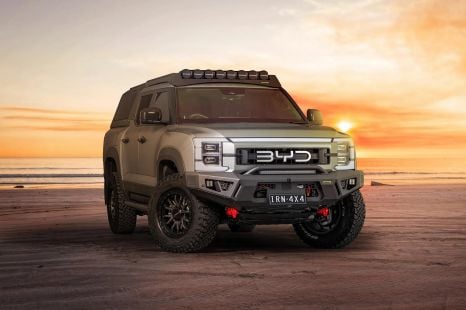

William Stopford
BYD Shark 6 gets higher payload thanks to GVM upgrade
3 Hours Ago
The Swift Sport is as good as ever in its Series II iteration, and like Suzuki's wider portfolio makes a strong case to the loyal customers who buy them.



Marketplace Editor

Marketplace Editor


Marketplace Editor

Marketplace Editor
Quickly see how this car stacks up against its competition. Select any benchmark to see more details.
Where expert car reviews meet expert car buying – CarExpert gives you trusted advice, personalised service and real savings on your next new car.
Carmakers have been pulling out of the light car segment lately, with low profit margins and the consumer shift to high-riding crossovers seeing many nameplates on hiatus or culled altogether.
Long-running and historically popular nameplates aren’t immune. The Ford Fiesta is now solely offered as the ST hot hatch, and the new-generation Hyundai i20 will only be available as a flagship performance hero sometime in 2021.
Meanwhile, France’s Peugeot 208 isn’t guaranteed and the Renault Clio has been canned for Australia. So too has the Honda Jazz.
There’s still plenty to like about city-sized hatchbacks, though, especially a range-topping performance model. One member of such a guild is the Suzuki Swift Sport, which has recently been updated as a ‘Series II’ model.
While never as potent as the Fiesta ST or as luxurious as a Polo GTI, the Swift Sport has long been a value-driven, fun-focused model covering all the basics, mixed in with the Japanese brand’s bulletproof reputation for reliability. The recipe is mostly unchanged, but today’s economic climate continues to force prices up, to the point where it’s nearly on par with said rivals.
How does Suzuki’s latest iteration of the Swift Sport stack up? And, should you buy one?
For 2020 the Swift Sport Series II kicks off at $26,990 before on-road costs for the standard six-speed manual, and $28,990 plus on-roads for the six-speed paddle-shift automatic on test here.
Right now, Suzuki Australia is advertising drive-away pricing for both versions, listed at $28,990 and $31,990 respectively.

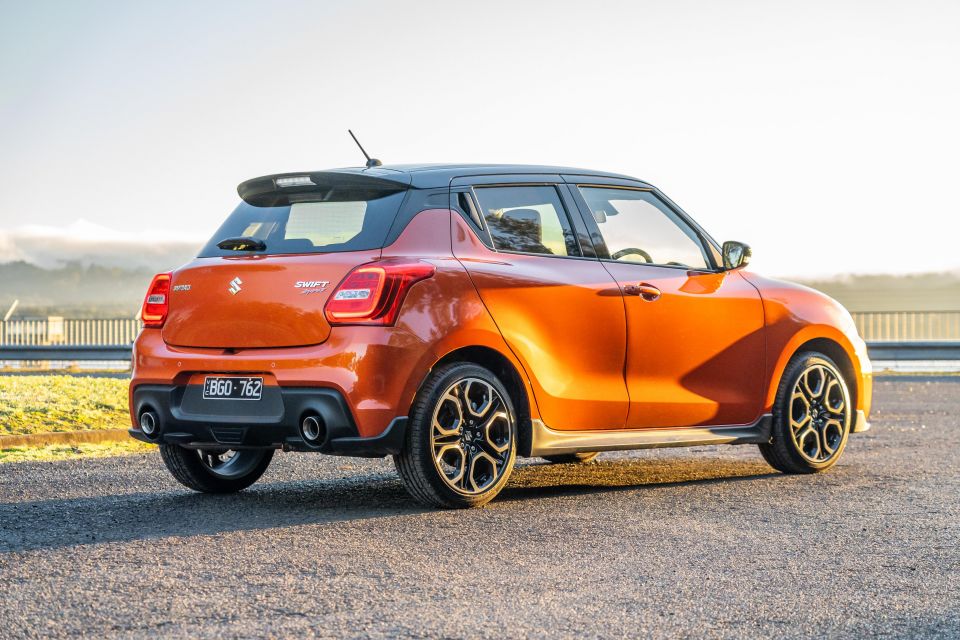
Both the manual and auto are $1500 dearer than the pre-update version (before on-roads), and the only options are premium paints.
Single-tone finishes other than Pure White will cost you an additional $595, while the new for 2020 two-tone Flame Orange with Black roof is $1095 extra.
The vehicle you see here is worth $33,085 on the road. By comparison, the Volkswagen Polo GTI can be had for $35,490 drive-away at the time of writing with three years of servicing thrown in, and a Fiesta ST is $31,990 before on-roads or just over $36,000 plus on-roads (in Melbourne).
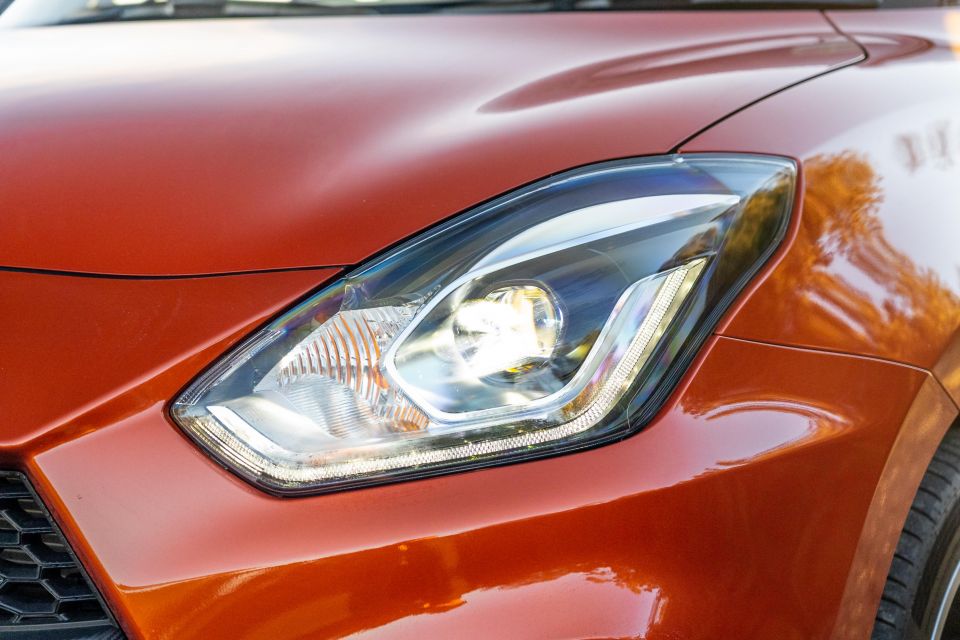
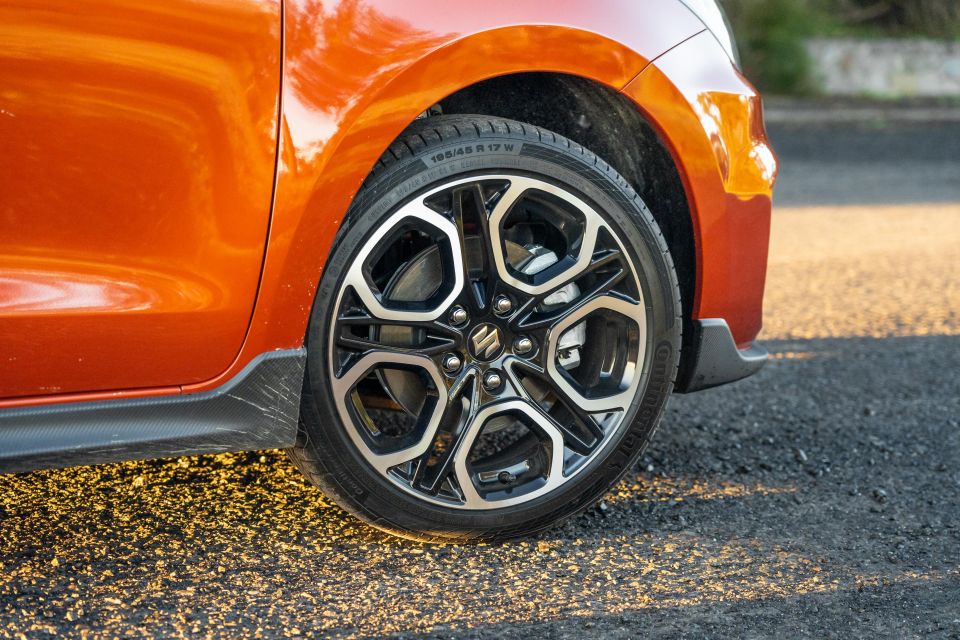
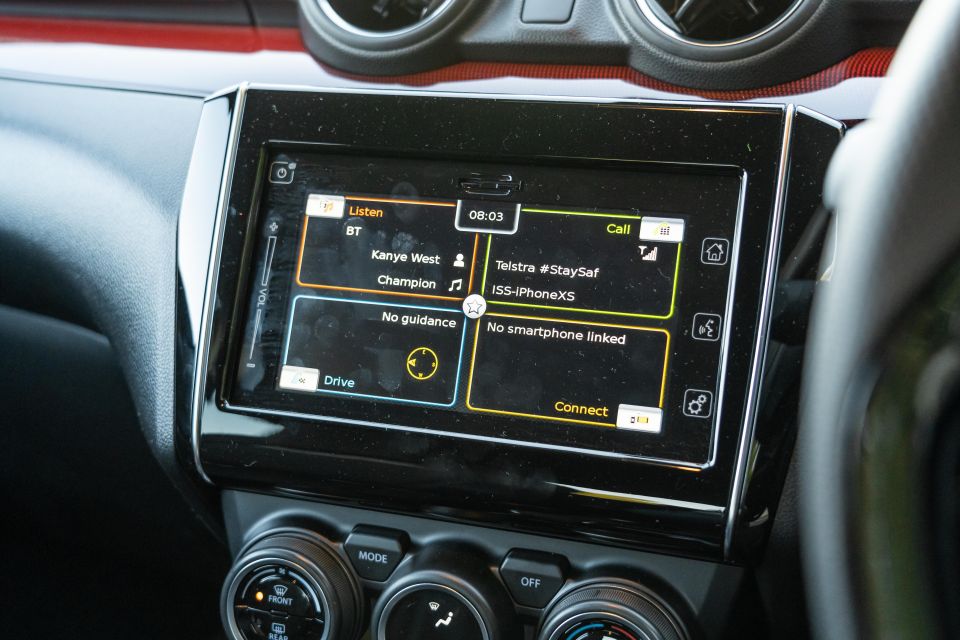
Buy your new car without the stress. It's fast, simple and completely free.

Great service from Travis and team, second time I have used this business would not hesitate to recommend them to anyone
Craig C.
Purchased a Ford Ranger in Sunshine Coast, QLD
CarExpert helped Craig save $7,224 on his Ford Ranger, now let us save you on your next new car.
Get your BEST priceAs you’d expect from a tiny mainstream car costing over $30,000, the Swift Sport is well equipped and comes with some new kit for 2020.
Over last year’s model, the Series II Swift Sport gets blind-spot monitoring with rear cross-traffic alert, a digital speedometer readout (finally!), and heated side mirrors.
That’s in addition to the existing feature list, which includes a 7.0-inch touchscreen with satellite navigation, Apple CarPlay and Android Auto, adaptive cruise control, single-zone climate control, keyless entry with push-button start, and semi-bucket seats with red stitching and ‘Sport’ embossed logo.
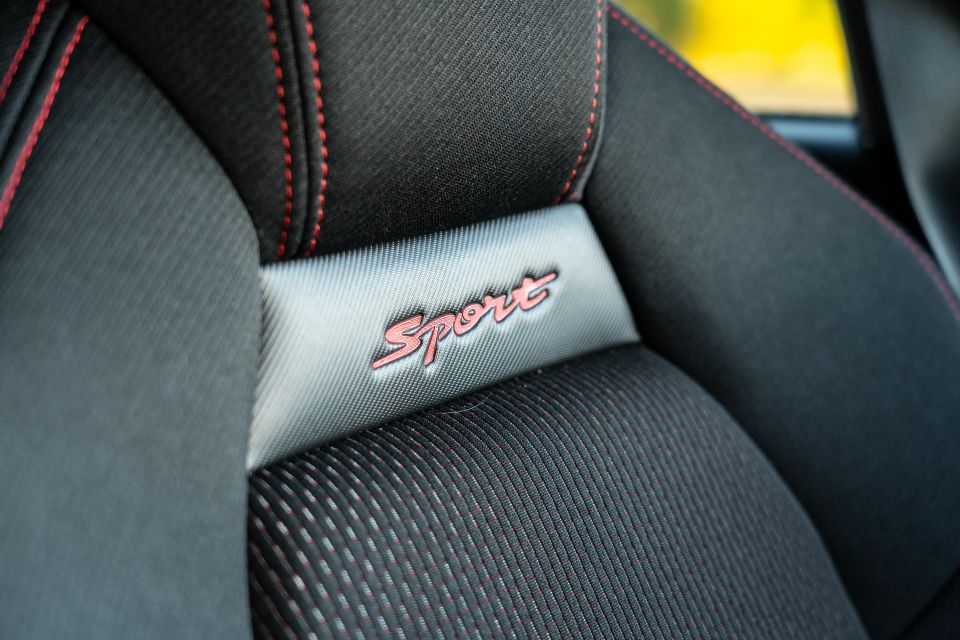
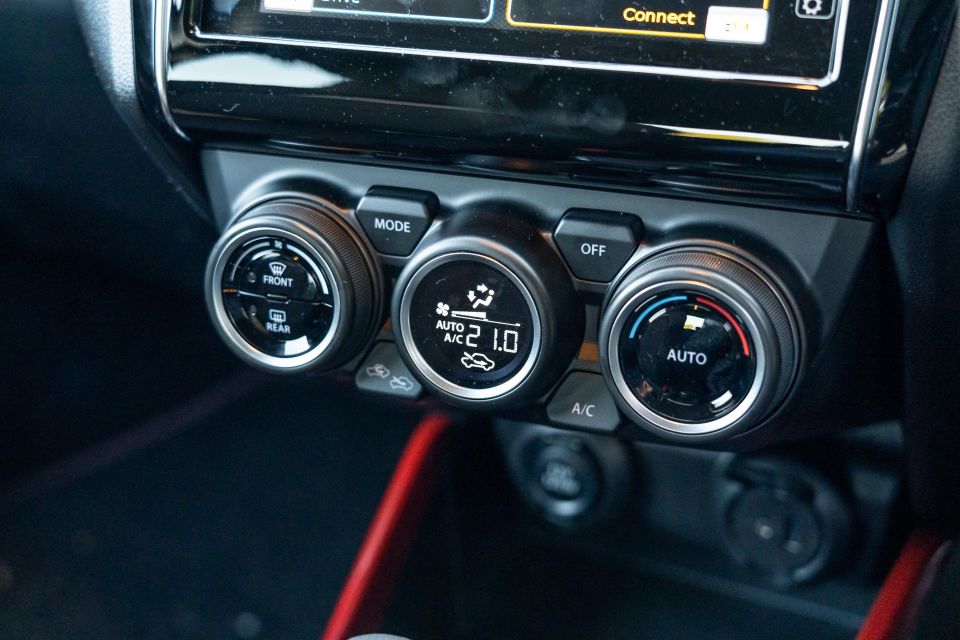
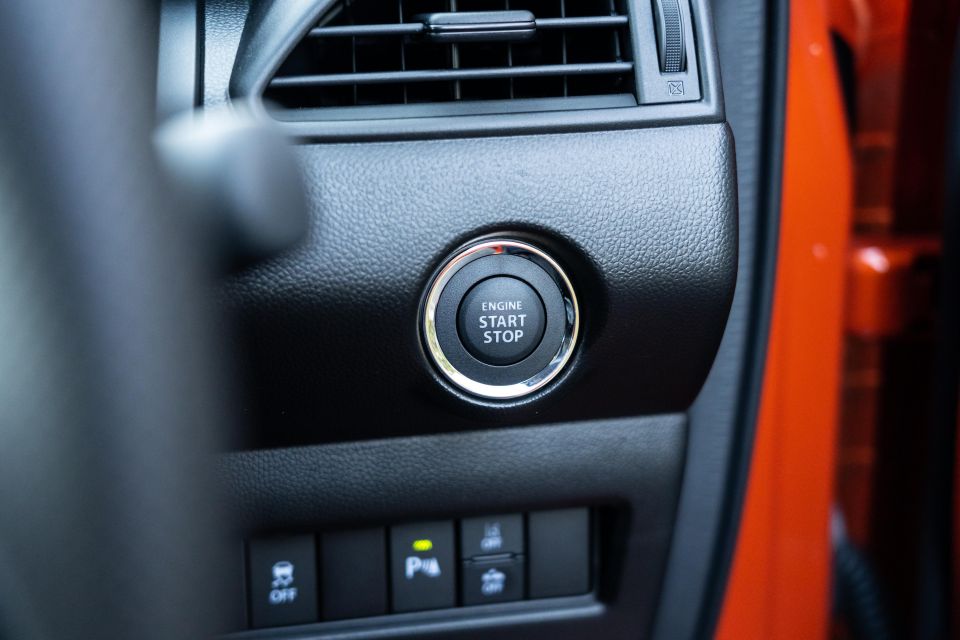
Other goodies include a D-shaped steering wheel, autonomous emergency braking (AEB), lane departure warning, weaving alert, high-beam assist, 17-inch alloy wheels, automatic LED headlights with LED daytime-running lights, fog lights, privacy glass, and electric folding side mirrors.
It’s certainly doesn’t want for much relative to its rivals, though you can’t get leather seats, which will disappoint some, nor a sunroof. There’s also no launch control like the Fiesta ST or Polo GTI, no electronic or mechanical front differential, and you can’t get some higher-end driver assistance features like you can on the Volkswagen – i.e. stop & go for the adaptive cruise control (cuts out under 30km/h) or an automated park system.
Minor omissions in equipment aside, the Swift is well-equipped and the extra features for MY20 are welcome in today’s tech- and safety-conscious market.
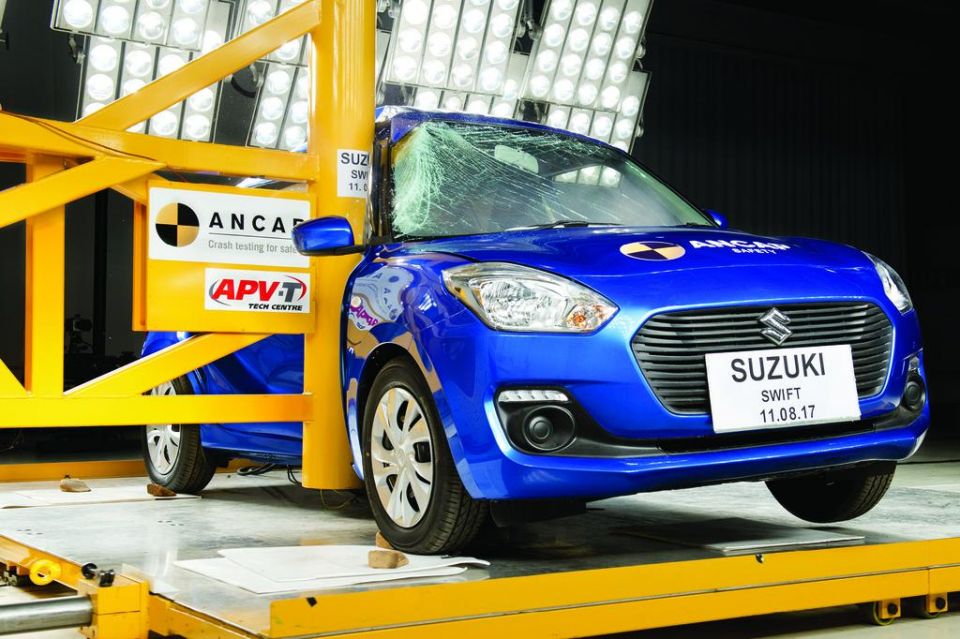
The Suzuki Swift line-up wears a 2017-dated five-star ANCAP safety rating, if you exclude the now-defunct GL entry model that lacked safety technologies like a reversing camera.
Based on older protocols, the Swift scored 35.13 points out of a possible 37, including a perfect score in the pole test and a near-perfect 15.74/16 in the side impact test. Whiplash and pedestrian protection were both rated ‘Good’, with 3/3 points awarded for the standard-fit seatbelt reminders.
In Euro NCAP testing, however, the Swift only scored four stars in 2017 when fitted with the optional Safety Pack – closely aligned in specification to the vehicles offered locally and more in line with stricter safety standards implemented in Australia at the start of 2019.
The Swift scored 88 per cent for adult occupant protection, 75 per cent for child occupants, 69 per cent for pedestrian protection and 44 per cent for safety assist.
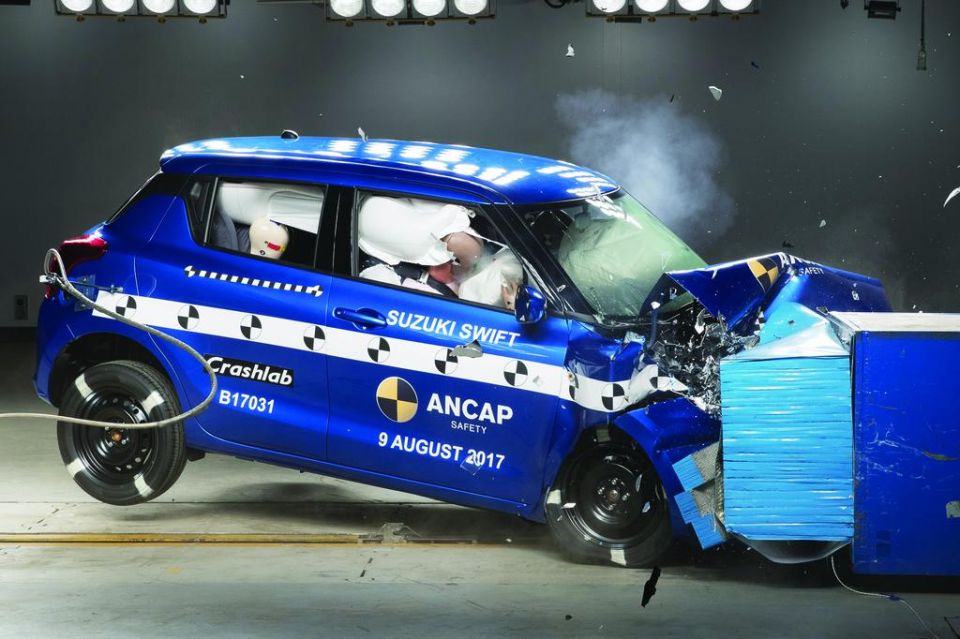
Key feedback from the crash-testing authority included marginal chest protection for the driver during the frontal offset test as well as marginal chest protection for the driver and front passenger in the full width assessment. Rear-seat whiplash protection was also rated ‘Poor’, as was chest protection for a six-year-old child in the frontal impact test and chest protection for a 10-year-old child in the lateral impact test.
In the area of safety assist, the Swift lost points for the lack of pedestrian detection with its optional AEB system, though the collision-mitigating technology’s functionality was rated ‘Good’ at urban and highway speeds (5-210km/h). The lack of a driver-set speed limiter (available separate to the safety pack) also cost the Swift points in this area.
Dual frontal, side chest and side head-protecting (curtain) airbags are standard, as are ISOFIX child seat mounts on the outboard rear seats. Autonomous emergency braking (AEB), adaptive cruise control and lane-departure warning are standard on the Swift Sport.
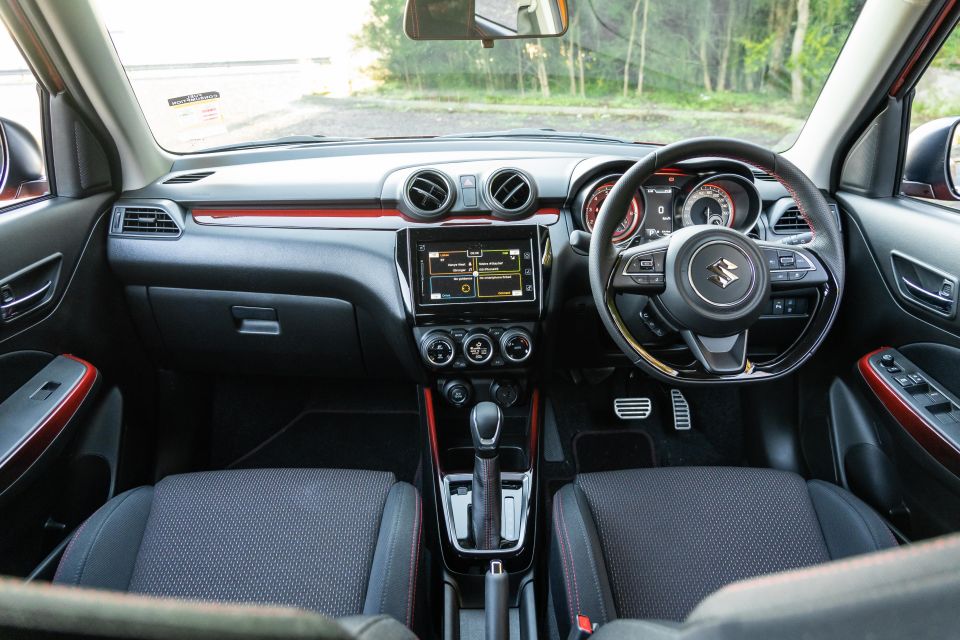
As tends to be the case with Suzuki’s line-up, the overall cabin design presents well, but it’s far from being plush or upmarket, particularly compared to rival models.
The layout of the controls is logical, clean and ergonomically sound. Everything looks nice on first glance and all the main touch points – like the steering wheel, gearshift and door elbow rests – feel of a high quality.
Poke and prod around a little more and you can see where costs have been cut and weight has been saved. The plastics throughout the interior are pretty much exclusively hard and scratchy, with the upper door trims being so slim they shift a little if you press them.
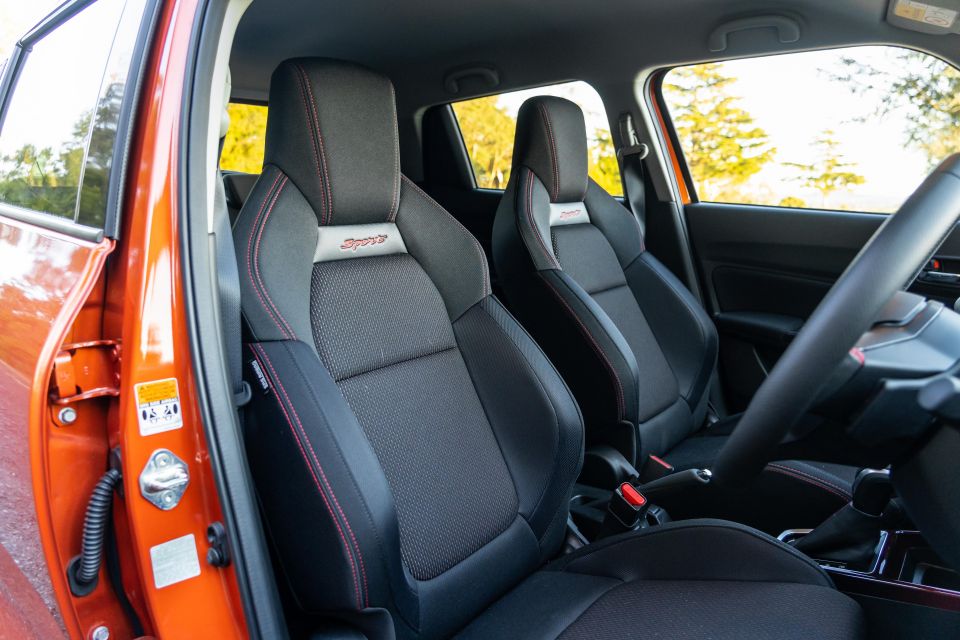

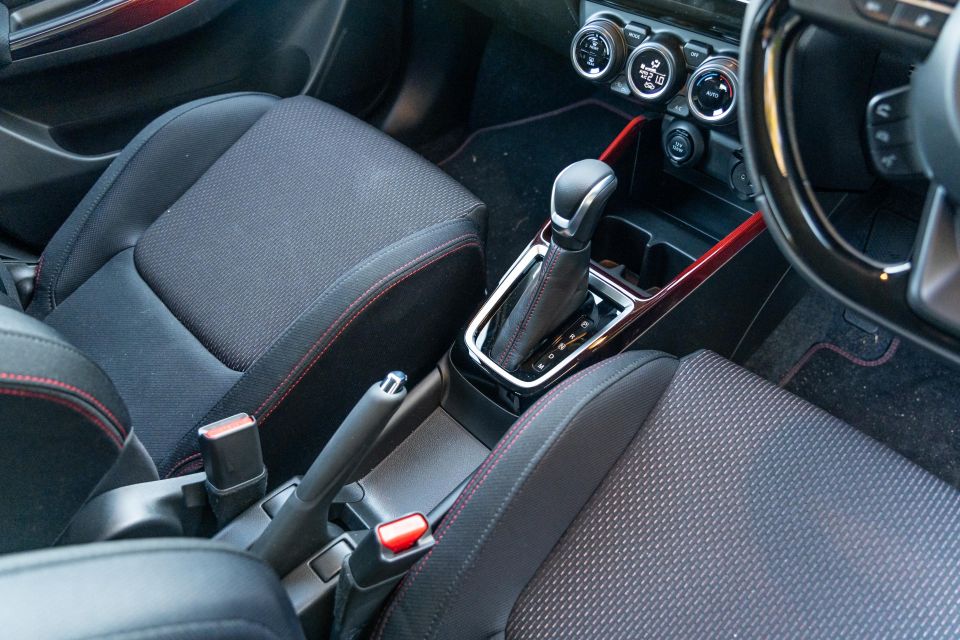

There’s also no centre armrest for front-row occupants, and we found a piece of plastic lining the left side of the driver’s footwell that came loose – CarExpert‘s Paul Maric got his foot stuck on it while filming. Otherwise, everything felt pretty well screwed together.
You’ll appreciate the comfort of the soft, supporting front bucket seats though you may find they hug you a little too tight if you’re a little wide in the hips. I’m no Beyoncé but felt a little too caressed around the derrière, particularly after longer stints behind the wheel.
The Swift’s tall, boxy proportions mean it feels quite airy inside despite its compact dimensions, with good head- and legroom for front and rear passengers. I had no issues sitting behind my own driving position, and I’m a little over six-foot-one.
Infotainment is fine without being standout. The 7.0-inch touchscreen with navigation and wired smartphone mirroring is well-featured, but lacks the processing power and fluidity of rival interfaces such as Ford’s fantastic Sync 3 system or Volkswagen’s proprietary MIB software.
There’s a six-speaker audio system to pump out your beats, which does the job just fine. It’s not quite as crisp as we’ve sampled elsewhere and turning up the volume (and bass) can make things a little shaky.
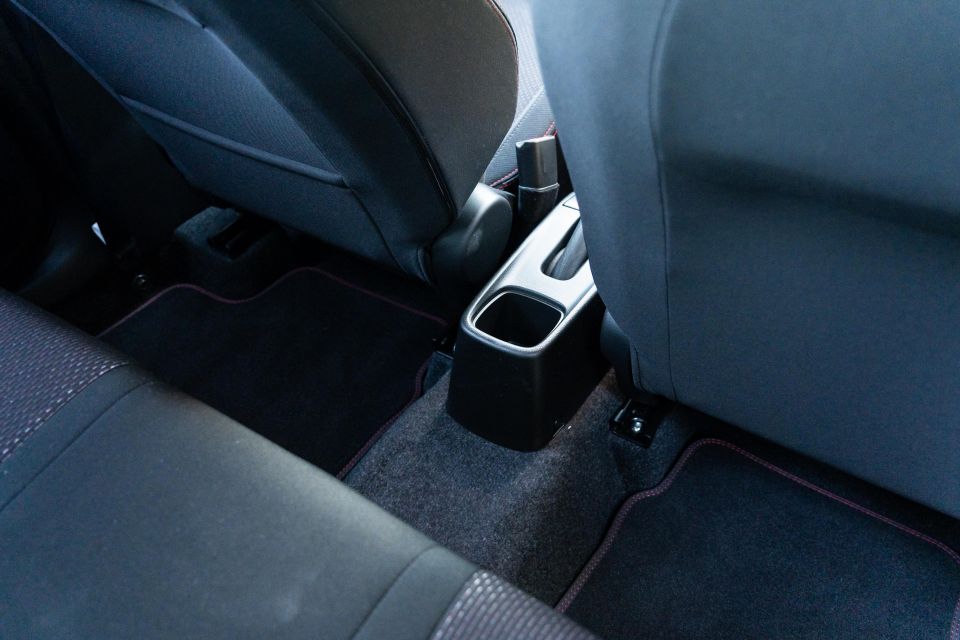
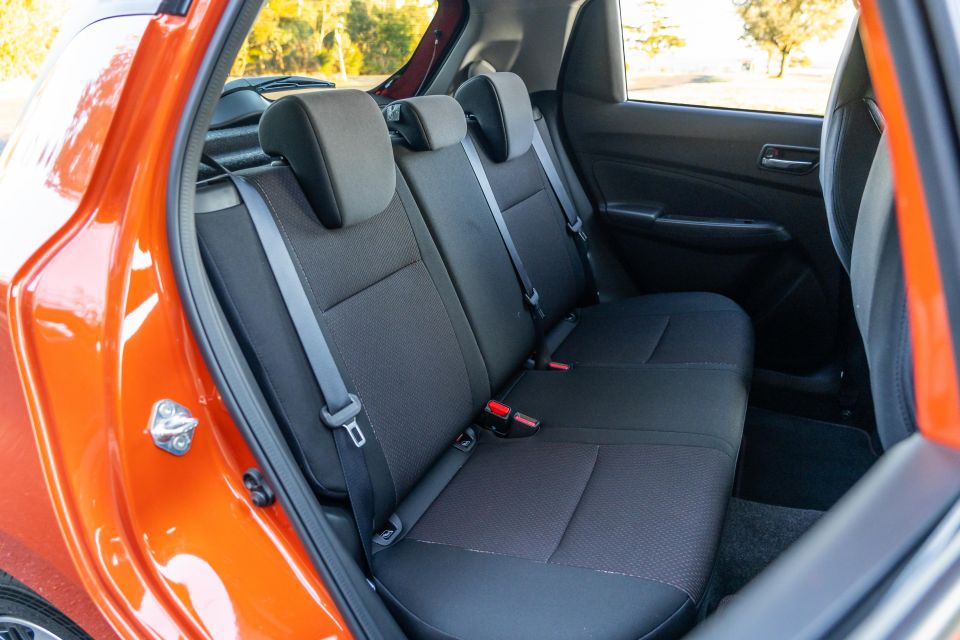
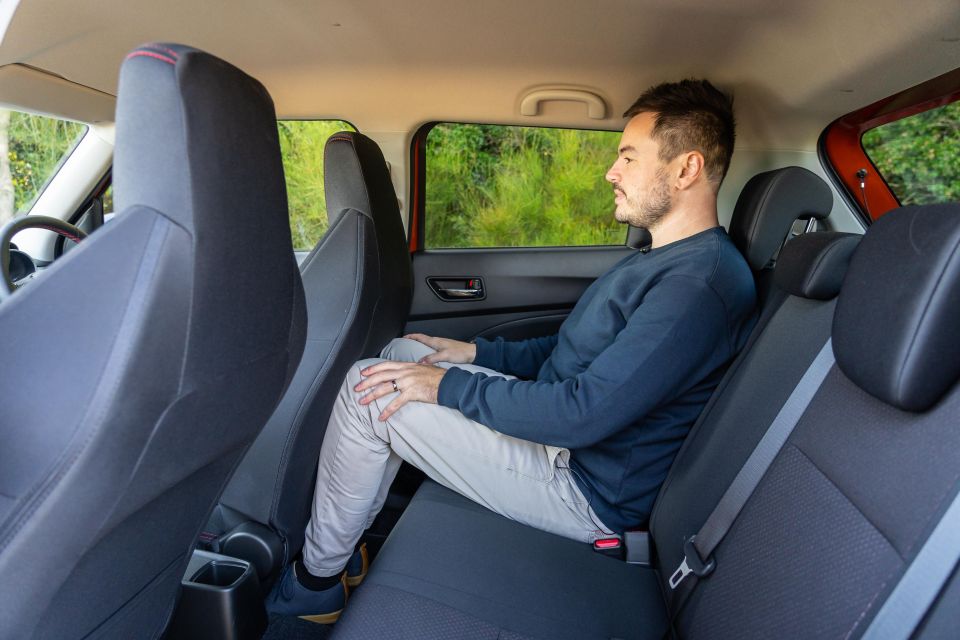
Storage, meanwhile is adequate without being outstanding. There’s a cubby and cupholders under the centre stack, but two large cups or bottles won’t be able to sit alongside each other comfortably – at least the door bins are quite decent.
The lack of a centre armrest up front also reveals a shallow cubby for keys or a wallet, although I wouldn’t be leaving anything of value there while the car is parked, as it would be in plain view.
There’s little in the way of rear-seat amenities – there’s no vents or fold-down armrest, although there’s a map pocket behind the front passenger seat.
There’s also space in the door bins for a bottle, but that’s about it. ISOFIX child seat mounts feature on the outboard pews, as well as top-tether points for all three rear seats.


Behind that second row the Swift Sport offers 265L of cargo volume with the seats in place – well off the 300-something volumes quoted by the rival Ford and Volkswagen.
Folding the rear bench opens up 918 litres, again nothing special, and the lack of an adjustable boot floor means there’s a large ‘step’ between the floor and seat back should you need to carry longer items.
There’s also no spare wheel under the boot floor – space saver or full-size – instead Suzuki opting for a tyre repair kit.
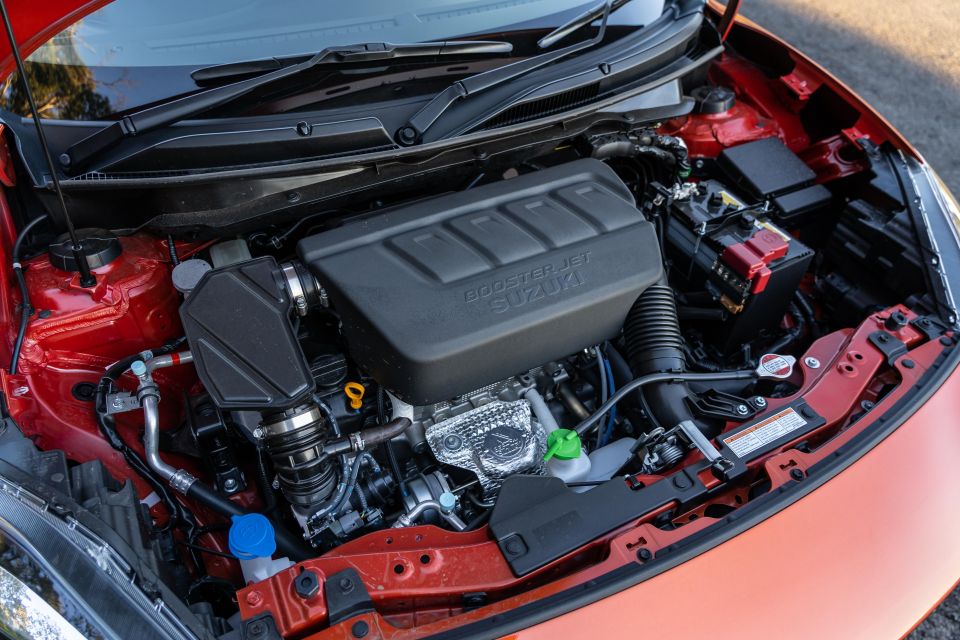
As before, the Swift Sport is powered by a 1.4-litre ‘Boosterjet’ four-cylinder turbo petrol engine in Australia, which develops 103kW of power at 5500rpm and 230Nm of torque between 2500 and 3000rpm.
Our test car is fitted with the optional six-speed automatic with paddle shifters, though a six-speed manual is the standard transmission.
Suzuki Australia doesn’t officially quote a 0-100km/h time for the Swift Sport, though overseas there are claims of 8.1 seconds floating around.
While outputs and performance times appear way off rivals on paper, the Swift Sport’s lightweight construction means the automatic tips the scales at just 990kg (kerb), making it about 200kg lighter than a Fiesta ST and 300kg lighter than a Polo GTI.

In fact, the Swift Sport’s power-to-weight ratio of 106.2kW/tonne isn’t far off that of the larger Polo, which quotes 114.4kW/tonne.
Claimed fuel consumption, meanwhile, is 6.1L/100km for the Swift Sport regardless of whether you choose the automatic or manual version, requiring a minimum of 95 RON at the bowser.
In emissions-conscious overseas markets like Europe and the UK, the Swift Sport now gets an electrified version of the same powertrain, combining a detuned version of the 1.4-litre turbo with 48V mild-hybrid technology – making for outputs of 96kW and 235Nm.
Suzuki’s local division hasn’t indicated whether it has concrete plans to import the hybridised Swift Sport – or any electrified variant of its models for that matter – though it has voiced interest in the past.
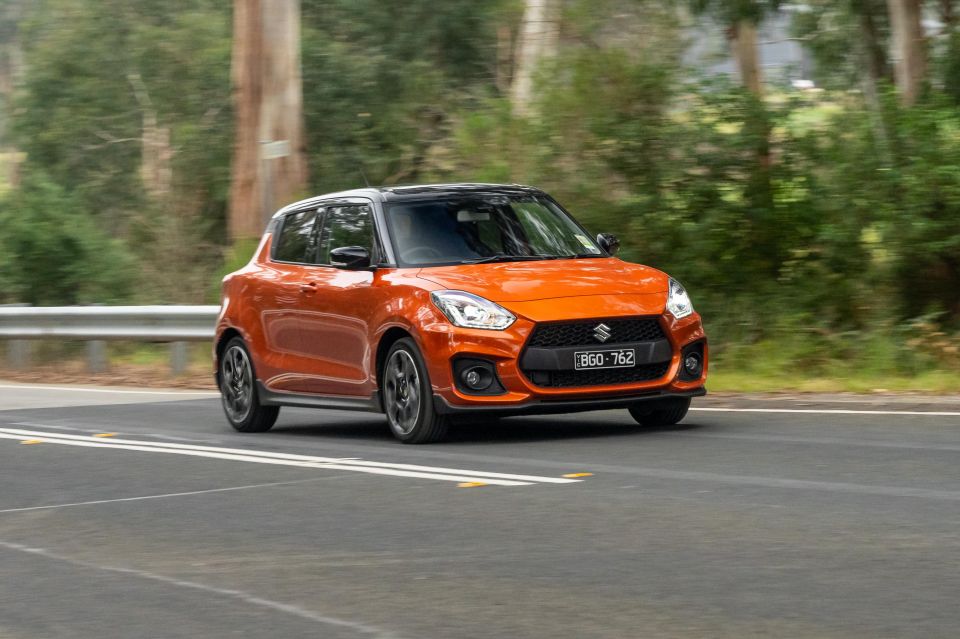
Rather well. I’ve driven both manual and auto versions of the Swift Sport in pre-update forms, and owners of the first series of this generation will find it’s more of the same. That’s mostly a great thing.
Given its size and underpinnings, the Swift Sport performs and drives like a larger, more expensive car. It’s a great daily, offering decent insulation from the outside world and a very comfortable ride across all environments, but also has plenty of pep so you don’t feel like you’re driving a weedy, budget econobox.
The ‘Boosterjet’ four-pot turbo has a very, ahem, boosty nature. Having peak torque wait until 2500rpm means you get a nice shove in the back once the turbo spools up, and the revvy nature of the petrol engine means it’s a fun, lively little thing to fling around.
It feels faster than it is, too, thanks to the meaty mid-range and featherweight chassis. That translates to a fun and engaging experience as the black stuff gets twisty. We’d like a gruffer exhaust note though, it lacks the character of rivals like the three-cylinder Fiesta and the burbly four-cylinder in the Polo.
The softer suspension tune and tall body means there’s a bit of lean in the corners, but it never feels unsettled or clumsy. It’s much like how the Mazda MX-5 rolls a bit, but is no less fun or engaging for it.
Like before, the Swift Sport Series II wraps Continental ContiSportContact 5 rubber around the 17-inch alloys, running a skinny 195/45 profile – by comparison, a Fiesta ST runs grippier 205/40 R18 Michelin Pilot Sport 4S rubber.
These tyres are good all round but you can’t escape physics when it comes to their skinny dimensions. You’ll find the Swift Sport’s limits rather quickly if you push hard on a winding road, with the lack of torque vectoring or a limited-slip front diff allowing a bit of wheelspin under hard acceleration or spirited cornering.
With that said, it doesn’t mean the Swift is any less fun. In fact it’s quite the opposite. It makes it more fun to drive more of the time, and you don’t have to be breaking the law to access most of the Swift’s dynamic talents.
I also found the cabin to be a little quieter on coarse-chip roads than I remember from the previous model, though Suzuki hasn’t said whether any developments were made in terms of NVH levels.
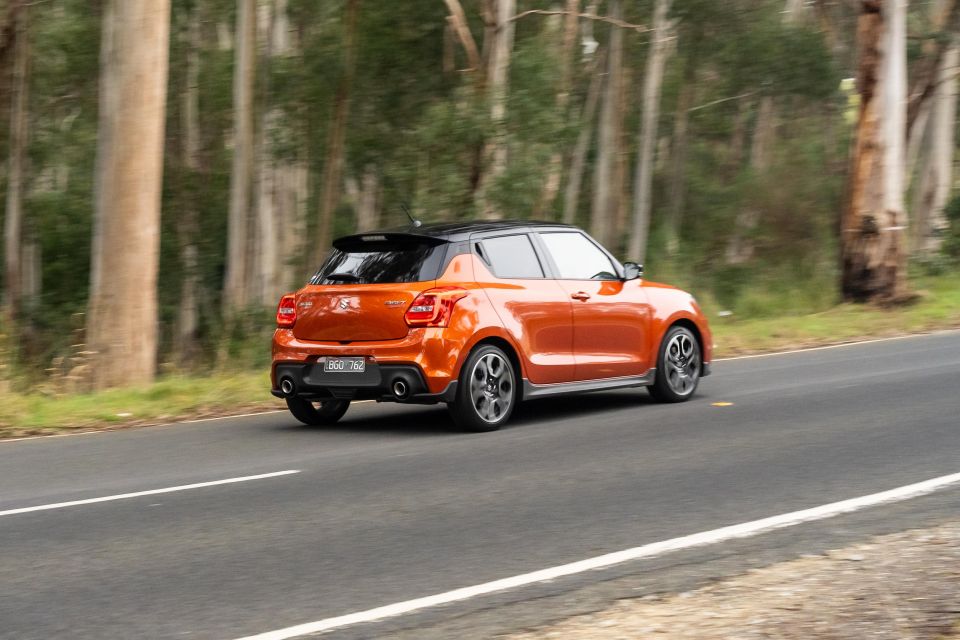
Where expert car reviews meet expert car buying – CarExpert gives you trusted advice, personalised service and real savings on your next new car.
We had plenty of opportunity to use the new safety tech on board too, with blind-spot monitoring proving handy on busy highways, while the digital speedo is a godsend in speed-conscious Australia.
Niggles about the adaptive cruise control and lane departure warning remain, however. First, the adaptive cruise system cuts out under 30km/h with a loud bing prompting you to take over. It can be indecisive when there are leading cars, regardless of distance, sitting a few kilometres under or over the speed you’ve set.
The lane departure warning system, dubbed ‘weaving alert’ also does little to stop you from drifting out of your lane other than a notification in the cluster and a vibration through the steering wheel.
Given the vehicles the Swift competes with and its availability in the European market, it’s surprising Suzuki hasn’t developed a proper lane-keep assist system like those available on numerous rivals.
All told, however, the little Swift is a hoot to drive in just about any situation.

Like the wider Suzuki range, the Swift Sport Series II is covered by a five-year, unlimited-kilometre warranty with capped-price servicing.
Scheduled maintenance is required every 12 months or 10,000 kilometres, whichever comes first. Suzuki’s turbocharged models have shorter mileage intervals – non-turbo vehicles require maintenance every 15,000km.
The first three visits will set you back $239, $329 and $239 respectively, totalling $807 for the first 36 months or 30,000 kilometres.
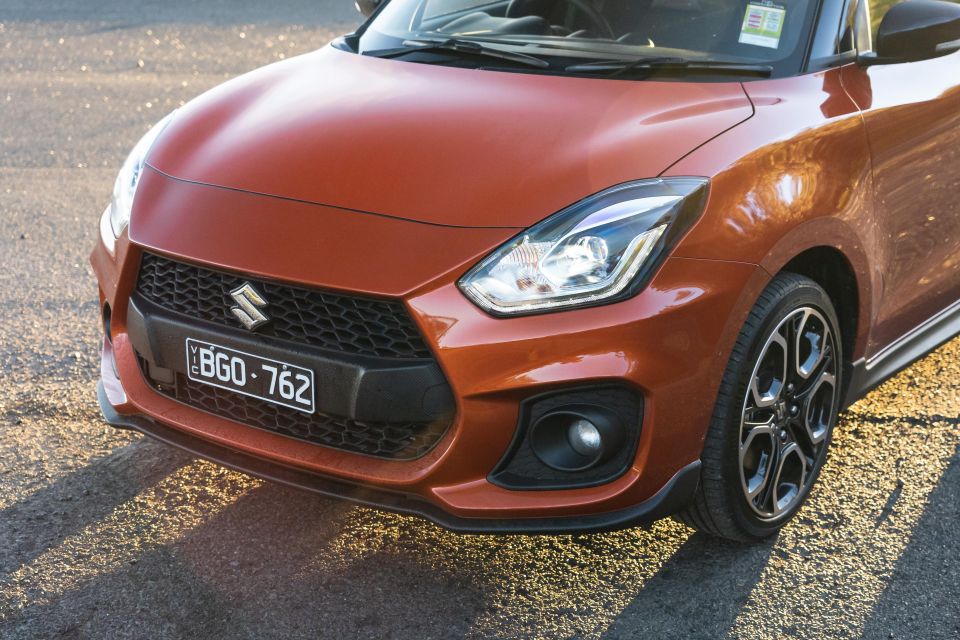
Suzuki’s capped-price servicing plan covers up to 100,000km provided the vehicle is under 60 months old (five years) – the fourth to tenth services are listed at $429, $239, $529, $259, $599, $259, and $299.
In terms of real-world fuel consumption, we achieved an indicated readout of 7.1L/100km with a good mix of urban commuting and longer stints on the highway.
The Swift Sport offers a teeny 37L fuel tank, meaning you can achieve around 500km between fills. Anecdotally we managed to cover about 460km before the fuel light came on, with an indicated 45km remaining.

Buy your new car without the stress. It's fast, simple and completely free.

Great service from Travis and team, second time I have used this business would not hesitate to recommend them to anyone
Craig C.
Purchased a Ford Ranger in Sunshine Coast, QLD
CarExpert helped Craig save $7,224 on his Ford Ranger, now let us save you on your next new car.
Get your BEST priceThe latest Suzuki Swift Sport is a good thing, but increased pricing means its value, previously a big selling point, is no longer as strong.
It has the makings of a great hot hatch – compact dimensions, relative practicality, daily drivability, sporty performance, engaging dynamics and low running costs – but it’s getting too close to proper performance hatchbacks like the Fiesta ST and Polo GT in that area.
Regardless, the Swift Sport is as fun as ever in its Series II iteration, and like Suzuki’s wider portfolio makes a strong case to the loyal customers who buy them. It just may not attract new buyers from other brands.
Where expert car reviews meet expert car buying – CarExpert gives you trusted advice, personalised service and real savings on your next new car.
James Wong is an automotive journalist and former PR consultant, recognised among Australia’s most prolific motoring writers.


William Stopford
3 Hours Ago


Ben Zachariah
5 Hours Ago
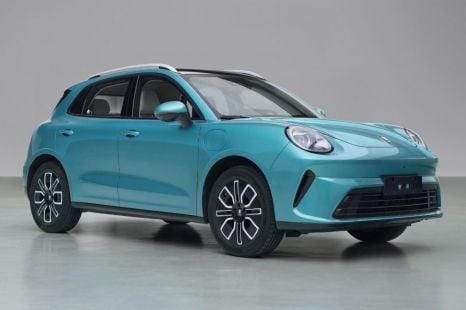

William Stopford
5 Hours Ago
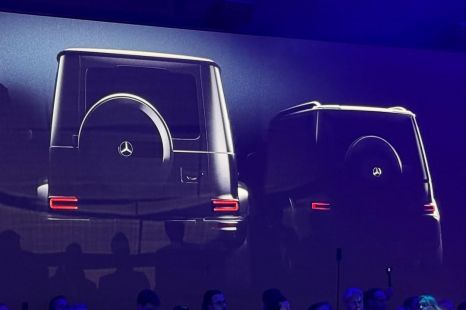

Ben Zachariah
8 Hours Ago
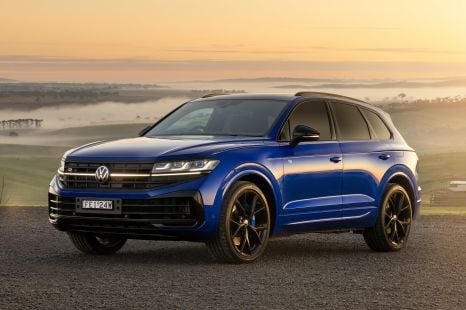

Damion Smy
8 Hours Ago
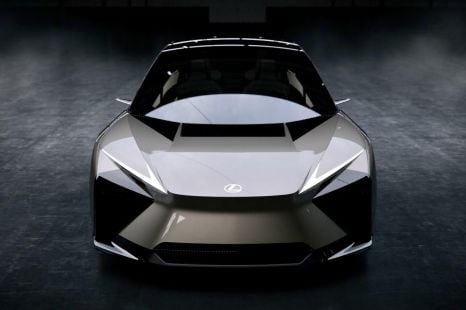

Ben Zachariah
8 Hours Ago